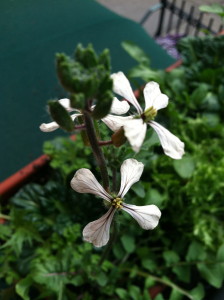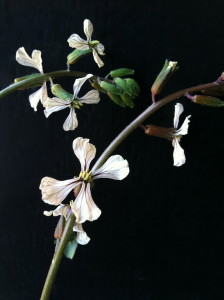For years I’ve read that cruciferous vegetables–including broccoli, cauliflower, and, yes, arugula–took the name “cruciferous” from for their cross-shaped flowers. But no matter how many heads of broccoli I bought at the market, I never saw the blossoms, and the connection remained purely theoretical.
I let the flowers grow, because I was so intrigued with them, despite knowing that you should never, ever let a food-producing plant go to seed if you want it to keep producing. In the case of arugula, in fact, once the plant produces flowers, the leaves will be bitter, so chefs advise against using them. But here’s the cool thing. You can eat the flowers. Last night’s salad contained about a dozen of the decorative morsels–providing a fun conversation piece for those at the table.As for the leaves, I’ve blown my shot at obtaining a second batch of salad-worthy leaves from this planting. But as I’m learning, arugula grows like a weed. In fact, it is a weed. I saw huge thickets of it growing wild alongside country paths in northern Spain last month. So with the enthusiasm of the inexperienced, I bought some arugula seeds this weekend and should have a new crop in 2-3 weeks, if the June heat doesn’t scorch them. (What are the chances?) To avoid my mistakes, check out this fun and instructive video from the staffs of Fine Gardening and Fine Cooking. If nothing else, you’ll fall in love with the dog who can’t keep his nose out of the arugula patch.
Related post: Flowers of the Camino



Thanks for this info. I have been cutting these flowers off and discarding them!! No more. I’ll try today as there’s a new crop. ?